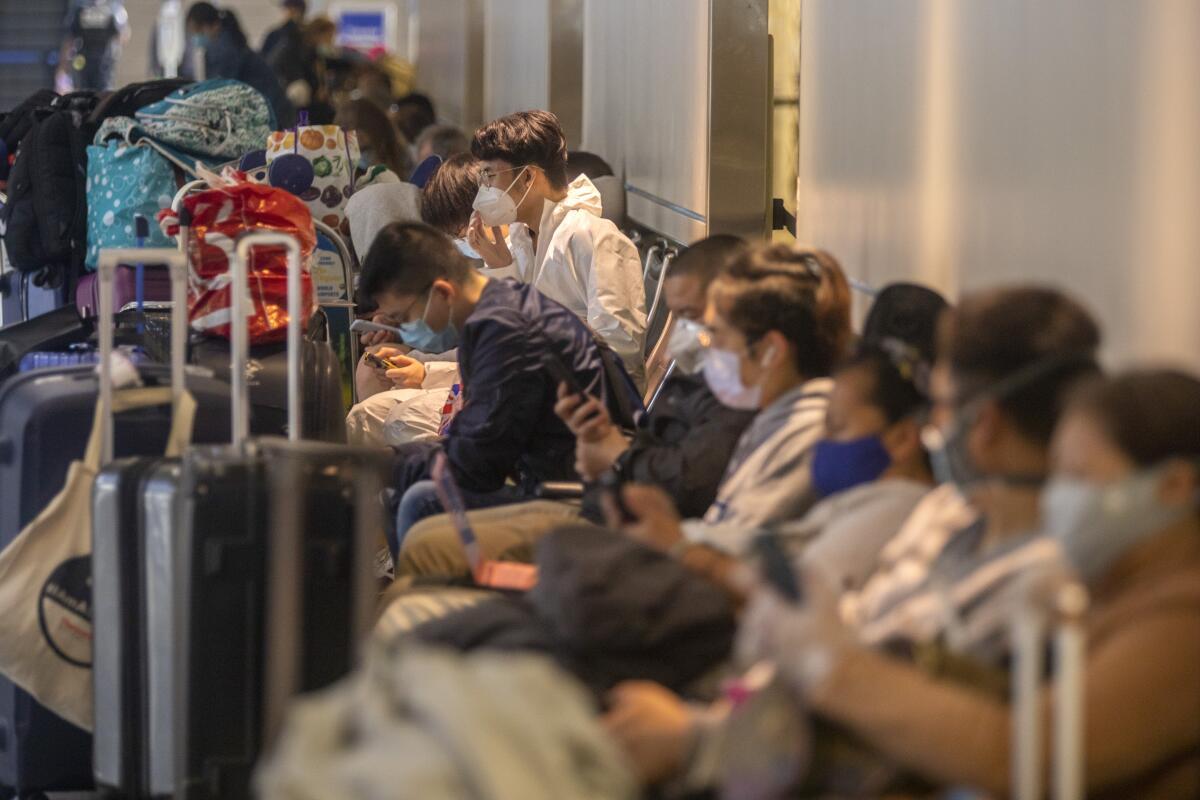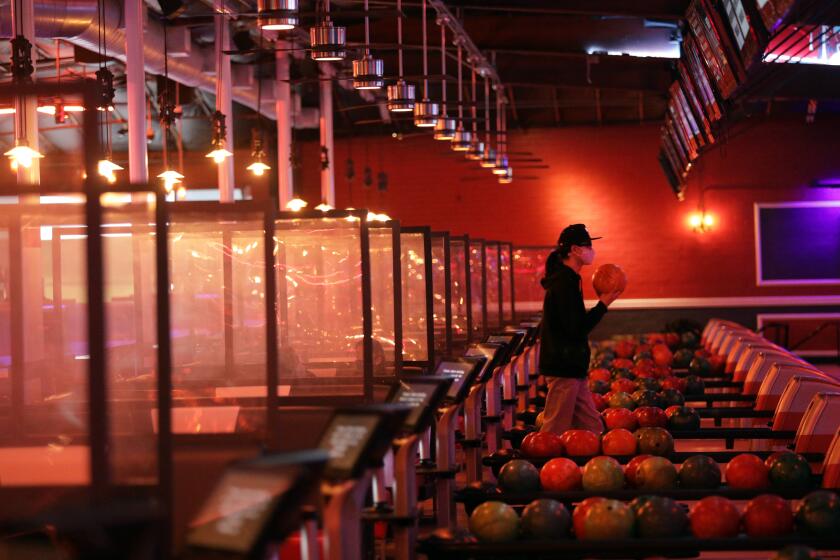An apparent fourth wave of COVID-19 is centered in the East. Will it hit California?

What appears to be a fourth wave of the COVID-19 pandemic has struck Michigan, the New York region and New England, and experts are uncertain whether it will remain contained.
“The United States has entered a fourth wave of transmission, and there’s no disputing this. Whether it remains as small regional outbreaks, or whether it generalizes nationwide remains to be seen,” Dr. George Rutherford, a UC San Francisco epidemiologist, said Friday at a campus town hall meeting.
Nationally, there has been an 8% week-over-week increase in the average daily number of newly diagnosed coronavirus cases, rising to about 62,000 for the seven-day period that ended Wednesday, federal officials said Friday. The average daily number of new hospital admissions for COVID-19 patients rose 5% over the same period.
California, where case numbers have dipped to levels not seen since the end of last spring, is in a much better situation. The state is reporting daily averages of 2,500 to 2,700 cases. (During the worst of the surge in the fall and winter, California was reporting 45,000 cases a day.) Additionally, California has had a coronavirus test positivity rate of 1%-2% over the last week — compared with 16% in Michigan and 9% in New Jersey.
“Here in California, we’re in much better shape — we do not have a spike. But I would point out that we’ve leveled off, and we’re not seeing continued declines,” Rutherford said.
He and others have expressed concern about Florida, the state with the largest concentration of confirmed cases of the U.K. coronavirus variant, B.1.1.7, which is more transmissible and possibly more deadly than the conventional strain. Florida has no statewide mask mandate, and crowds of spring break revelers are prompting fears that travelers will further spread the U.K. variant around the nation. Florida over the last week had a positivity rate of 9%, and it is climbing.
“We’ll have to see how that plays out,” Rutherford said.
In Michigan, the surge has accelerated since it began in mid-March, Rutherford said, and appears to be heading toward a peak similar to the state’s winter high. The Michigan surge appears to be tied to the U.K. variant and may have been precipitated by high school sports, Rutherford said.
“Elsewhere — in New York, New Jersey, Connecticut, Rhode Island, Massachusetts, Delaware — there’s a series of a kind of interlinked outbreaks, with more modest increases that seem to stem from metropolitan New York and spilling into the neighboring states,” Rutherford said.
Other national experts echoed Rutherford’s concerns.
“We’re heading into the fourth surge. Cases are increasing. Variants are increasing. Variants are more deadly,” Dr. Tom Frieden, a former director of the U.S. Centers for Disease Control and Prevention, said Saturday on ABC’s “Good Morning America.” “We just have to hang on until a larger proportion — particularly of the vulnerable — are well vaccinated and more of us are vaccinated, or we will have a large fourth surge. We will have a fourth surge, I’m afraid. How large and deadly? That depends on us.”
County officials say moving to a less restrictive category in California’s reopening blueprint is a hard-fought gain in the battle against COVID-19.
Some experts disagree, given how many people in the U.S. have either been vaccinated or have immunity because of a past coronavirus infection.
“I think that there’s enough immunity in the population that you’re not going to see a true fourth wave of infection,” Dr. Scott Gottlieb, a former head of the Food and Drug Administration, said Sunday on CBS’ “Face the Nation.” However, he added that there are indeed “pockets of infection around the country, particularly in younger people who haven’t been vaccinated and also in school-age children.”
Gottlieb said he believes schools can stay open if they adhere to pandemic safety practices: “As one epidemiologist referred to it this week, go the full ‘Harry Potter’ and try to keep students within defined social cohorts so that they’re not intermingling in large groups.”
California has the nation’s fourth-highest number of cases tied to the U.K. variant, according to federal data. A hopeful scenario envisions the spread of that variant in the state impeded by the California variant, B.1.427/B.1.429, which has been more prevalent here.
“Hopefully, we’ll be able to dodge this bullet, because this [U.K. strain] is a more transmissible strain and possibly a strain that causes more severe disease,” Rutherford said.
More than 32% of Californians have received at least one dose of a COVID-19 vaccine, and roughly 17% are fully vaccinated.
Recent data show that the currently available vaccines offer sufficient protection against the new variants. The vaccines produce an immune response “way more” than you need for the conventional strain of the coronavirus, Rutherford said. And even when they show diminished effectiveness against variants — such as South Africa’s B.1.351 and Brazil’s P.1 strains — the vaccines produce an immune response “two to three times more than you need,” Rutherford said. “So far, so good.”
Despite the positive news on vaccination, the leading health official in Northern California’s most populous county, Santa Clara, warned that the decline in daily case numbers there is slowing.
“We are now seeing our case rates flatten, and in some cases … some indication that they’re beginning to tick up. So we may have gotten as low as we’re going to go,” said Dr. Sara Cody, the health officer and public health director for Santa Clara County. “Unfortunately, we still all need to be very aware and very cautious to prevent any surge or even a swell. We don’t want that to happen.”
The likelihood of another surge — or a milder “swell” — hitting California will depend on vaccine supply and the behavior of residents.
“Vaccines are going to help, but we need more supply so we can get it out faster,” Cody said. “And we need people to just hold on for a little bit longer: Keep wearing your mask, delay your travel, don’t indoor dine, don’t go to indoor bars, don’t host an indoor gathering at your home. Even if it’s allowed under the state rules, don’t do it. It’s not safe. Not yet.”
Health officials have acknowledged the apparent contradiction in easing restrictions while at the same time voicing caution about a rise in cases.
However, some mixed messaging is to be expected when dealing with a new virus, according to Dr. Muntu Davis, L.A. County’s health officer.
“This is naturally what happens inside of a pandemic,” Davis said Friday. “As you start to see how the virus acts, as you start to see when you have new countermeasures, whether that be vaccine or treatment, then we start to learn more. But until we have that information, we have to operate with a lot of caution, because everyone is at risk.”
More to Read
Sign up for Essential California
The most important California stories and recommendations in your inbox every morning.
You may occasionally receive promotional content from the Los Angeles Times.














